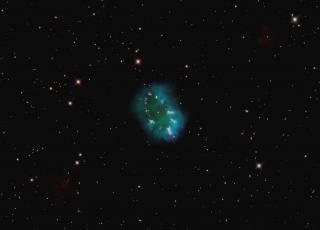Bibcode
Gonçalves, D. R.; Magrini, Laura; Teodorescu, Ana M.; Carneiro, Carolina M.
Referencia bibliográfica
Monthly Notices of the Royal Astronomical Society, Volume 444, Issue 2, p.1705-1720
Fecha de publicación:
10
2014
Número de citas
18
Número de citas referidas
15
Descripción
Here we study 16 planetary nebulae (PNe) in the dwarf irregular galaxy
NGC 205 by using Gemini Multi-Object Spectrographs (GMOS@Gemini) spectra
to derive their physical and chemical parameters. The chemical patterns
and evolutionary tracks for 14 of our PNe suggest that there are no type
I PNe among them. These PNe have an average oxygen abundance of
12+log(O/H) = 8.08 ± 0.28 and progenitor masses of 2-2.5
M⊙ and thus were born ˜1.0-1.7 Gyr ago. Our results
are in good agreement with previous PN studies of NGC 205. The present
12+log(O/H) is combined with our previous work and results in the
literature to study the PN metallicity trends of Local Group (LG) dwarf
galaxies, in an effort to establish the PN luminosity-metallicity and
mass-metallicity relations (LZR and MZR) for LG dwarf irregulars (dIrrs)
and dwarf spheroidals (dSphs). Previous attempts to obtain such
relations failed to provide correct conclusions because they were based
on limited samples. As far as we are able to compare stellar with
nebular metallicities, our MZR is in very good agreement with the slope
of the MZR recently obtained for LG dwarf galaxies using spectroscopic
stellar metallicities by Kirby and coauthors. In fact, we found that
both dIrr and dSph galaxies follow the same MZR, at variance with the
differences claimed in the past. Moreover, our MZR is also consistent
with the global MZR of star-forming galaxies, which span a wider stellar
mass range (˜106-1011 M⊙).
Proyectos relacionados

Nebulosas Bipolares
Nuestro proyecto persigue tres objetivos principales: 1) Determinar las condiciones físico-químicas de las nebulosas planetarias con geometría bipolar y de las nebulosas alrededor de estrellas simbióticas. El fin es entender el origen de la bipolaridad y poner a prueba los modelos teóricos que intentan explicar la morfología y la cinemática nebular
Antonio
Mampaso Recio